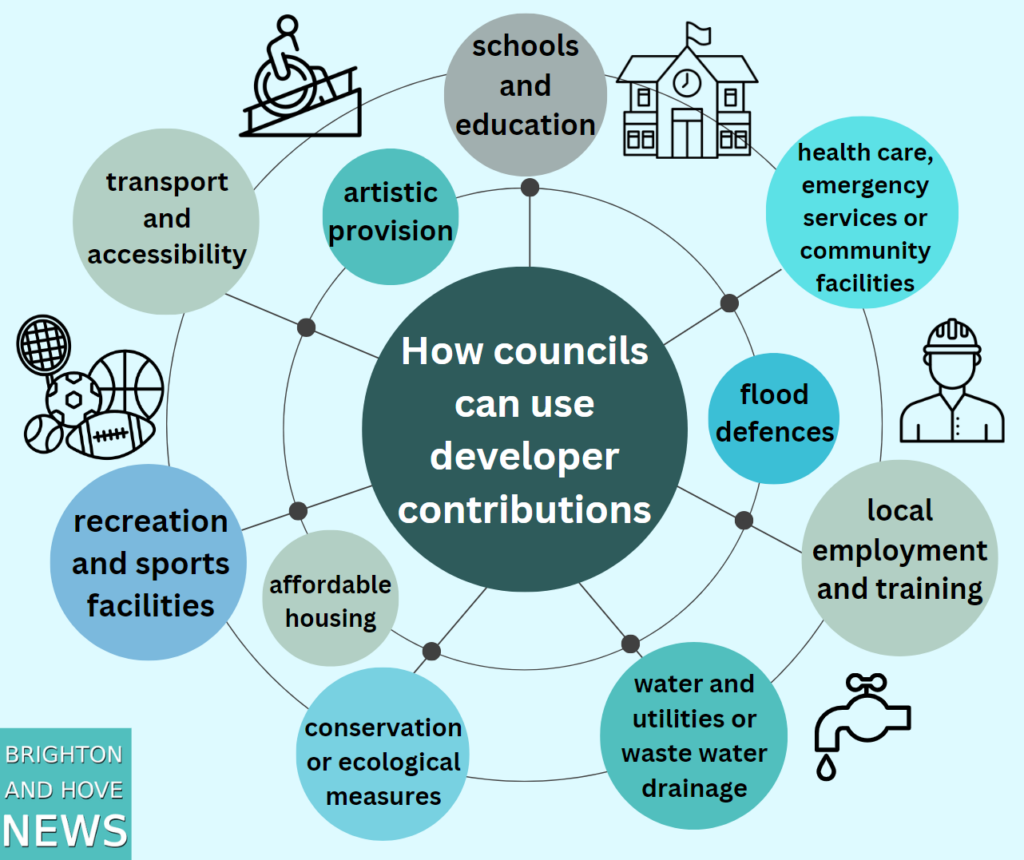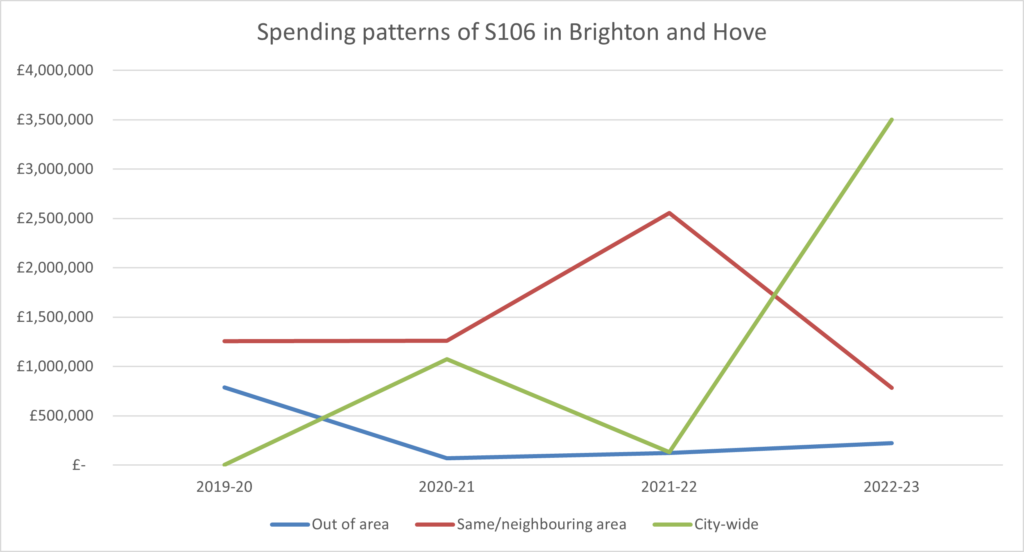Spending of developers’ payments to the community — commonly referred to as Section 106 (S106) money — has shifted significantly over the past four years, according to a detailed analysis by Brighton and Hove News.
These funds, generated during the planning approval process, are designed to mitigate the impact of new developments by investing in local infrastructure. However, recent changes in how the funds are allocated have sparked debate among residents and politicians.
What are developer contributions?
S106 agreements are financial commitments made by developers to offset the direct impacts of new developments, such as increased demand for schools, parks, or roads. These agreements are legally binding and often tied to specific, localised projects.
In 2020, Brighton and Hove began transitioning to the Community Infrastructure Levy (CIL), a broader funding mechanism aimed at addressing cumulative impacts of development city-wide. Unlike S106 funds, CIL payments are pooled and allow flexibility to allocate resources to large-scale infrastructure projects.
Thousands of developers’ contributions are agreed to every year, but not every developer who agrees to a contribution during the planning stage actually ends up paying.
Only the developments that actually get built and pass certain development thresholds will be subject to the payments.
This means that there are developments for which planning approval was first sought in 2012 which may have only made the S106 payment since 2019.

Shifting spending patterns
Brighton and Hove News used the council’s Infrastructure Funding Statements (IFS) from 2019 to 2023 to calculate which wards money was generated in through planning developments and which wards that money was spent in.
This data reveals that S106 funds are now less likely to be spent on particular projects outside the ward where they were generated, but simultaneously, city-wide spending has seen a marked increase.

projects. Source: BHCC IFS
In 2019-20, over £789,000 was spent on projects outside the wards where the funds were generated. By 2022-23, this figure had dropped to just over £221,000.
Meanwhile, spending on city-wide initiatives, such as affordable housing schemes and employment programs, surged from a mere £2,731 in 2019-20 to over £3.5 million in 2022-23. Despite these changes, the majority of funds remain spent within the originating ward or its immediate neighbours.
Over the past four years, £5.8 million has been spent on local projects, compared to £1.2 million spent outside the generating areas and £4.7 million allocated to city-wide initiatives.
View this post on Instagram
See how the top 10 largest developers’ payments were spent across the city here.
Resident concerns and criticism
The shift in spending patterns has not gone unnoticed by residents and council members. A key criticism has been the reallocation of S106 money away from the immediate areas affected by development.
For example, Moda Living’s £1.74 million contribution – generated by an 800-home project in Hove – sparked outrage when £800,000 of it was allocated to the Kingsway to the Sea project, now known as Hove Beach Park.
Independent councillor Samer Bagaeen criticised this decision at the time, stating: “The local community has spent two years working with councillors, Moda, and senior officers.
“We cannot see how re-purposing Moda section 106 monies to Kingsway on Sea mitigates the impact of the Moda development on the local community.”
Council response and strategy
Labour councillor Jacob Taylor, deputy leader and cabinet member for finance and city regeneration, defended the changes, emphasising the need for flexibility in addressing broader city needs.
Councillor Taylor said: “The impact of a development is not always just felt in the local area and having flexibility in the use of developer contributions allows us to focus them where they are most needed and will have the most impact.
“This is especially true with schools, where a development may have a significant impact on a secondary school outside of the ward the development is in. The same also applies to spending on sports and recreation, where funds are targeted on developing area hubs which provide specialist facilities which benefit the entire city.
“Some Section 106 payments are still being made by developers as old planning applications are implemented and trigger payments, with these funds still being used for schools, parks and other projects.
“It is important that those behind new developments contribute to the cost of improving local infrastructure to meet any increased demand.
“We are one of the only local authorities in the UK to share full details on Section 106 and Community Infrastructure Levy payments with our residents, who can access detailed information on our website.”
He explained that CIL contributions dedicate 15 per cent to 25 per cent of funds for use in the ward where the development occurs, with the rest supporting city-wide initiatives.
A balancing act
Brighton and Hove’s approach to developer contributions reflects the challenges of balancing local needs with city-wide priorities.
While the shift toward broader infrastructure investment offers long-term benefits, it has sparked calls for greater community input and transparency to ensure funds are allocated equitably and effectively.









Councillor Jacob Taylor has to defend a lot lately doesn’t he! Rather than defending the use of s106 money to plug gaps in council finances he could have a word with his colleagues in Government who are continuing the Tories austerity drive.
I agree with using contributions where it can be most effectively used, rather than limiting it to just the ward it was generated in. Utilitarian, and logical economy of scale. As long as the projects it is applied to follows a social criteria, it’s fine.
Regarding central government, that sounds like a good argument for devolution. It’s so much better to have power rebalanced to be run by more local people than someone up in Westminster.
This money can’t just be used to plug gaps in council finance.
It can only be spent on specific things.
It can’t be used to pay for social workers or refuse collection or other day to day expenses like gas and electricity.
If this money didn’t exist very few, if any, of the schemes it is spent on would actually happen.
That is true in theory – but where it is used in accordance with those strictures it relieves that particular budget allowing that budget to be re-allocated.
S106 has morphed into a general development tax.
How much was the i360 bribe?
It’s a strange ‘bribe’ that is included in a planning officers report to a committee tha meets in public and whose papers are also available for anyone to read.
The Hove Beach Park development is way behind schedule and must be well over budget. This overspend is ‘normal’ with a big project, and the builders and gardeners have also has unusual and bad weather to deal with.
But the planning gains funds redirected to top up the budget for this unique community project are very well spent, and the new seafront park is a huge success, bringing benefit for all residents in Hove.
This project is one of the few successes amongst the many changes we’ve seen in the city in recent years.
It’s just another way to ignore inconvenient regulations, requirements and obligations. The developer decides not to build the primary school, doctor’s surgery, supermarket and carpark in the contract, only build a third of the agreed properties classified for social use, no suitable public transport infrastructure but build double the top end luxury properties planned. How? Why? The massive profits means they just pay off the fines incurred as financial costs for the project.
The council will collect the money meant for project A but spend it on preferred project B.
Everyone involved says one thing, does another, points to something else, claims the moral victory whilst stuffing cash in off shore accounts. Legally.
Ridiculous conspiracy theory aside, CIL is a good way to generate money for social projects. It is absolutely a business decision when developers decide to take the hit by not fulfilling the social housing requirement.
The trouble is that if the council block it completely, it just ends up going to appeal, where 9/10 it will be upheld. When that happens, the city gets nothing, so there’s an element there of pragmatism one has to take on balance.
Otherwise, if you were inflexible, you’d end up with a load of the developers luxury buildings, and no money for any social housing.
the 106 system required the dee to be spent in the area of the development within 5 yrs or it was to be refunded as well.. one issue with cil fees is that it can add 20k to the cost of a three bed house wich will be added tot he sale price nt from any projected profit for the developer,
Although developers are required to build an element of social housing, this is usually refused by housing associations as they can’t afford it, so the developer makes a payment to the council.
and the ‘in lieu’ payments are totally separate from s106 or CIL levies
Interesting to see people defending a blatant centralisation of decision making. Section 106 was introduced to mitigate the effect of a development. It is inarguable that the impact of moda, for example, on the immediate locale will be profound. If the amount is calculated based on an acknowledgment of the potential impact, if not spent compensating the local area, then it is only being acknowledged in theory. This “we know better” mentality is unfortunately typical in terms of the trajectory of this country but the donuts are running the bakery now so what else other than doughy plans with massive holes in them is to be expected?
When are the road going to be done as the Lewes road to the to the bottom of bear road is like Earth quake when you drive 🚗 along it stop wasting money on stuff that doesn’t necessarily need doing do the jobs that need doing
Very specific question, best raised at area panel, or towards your ward councillor for a specific answer.